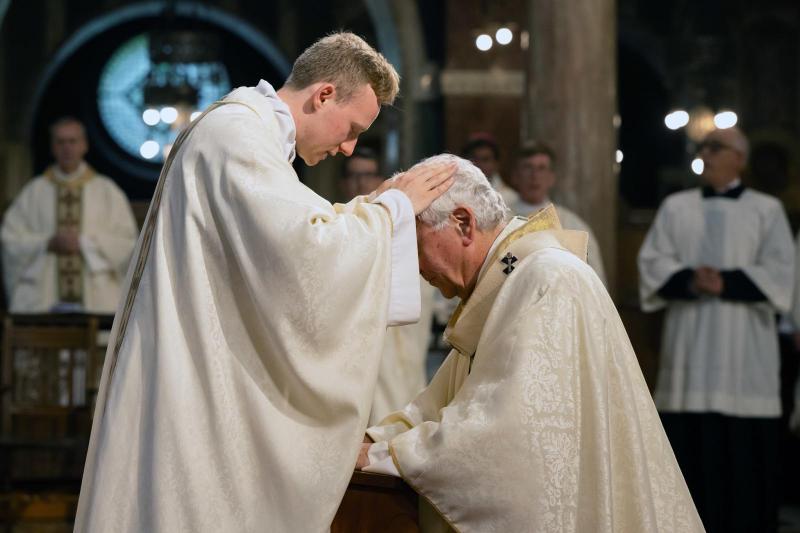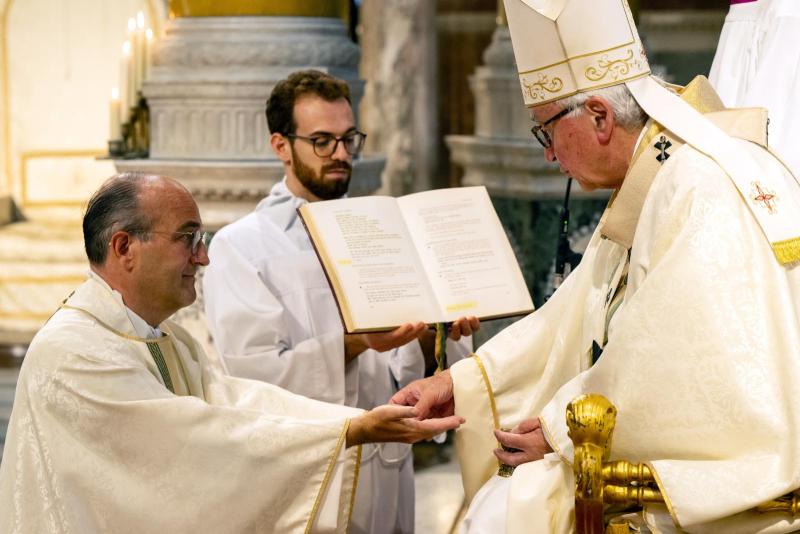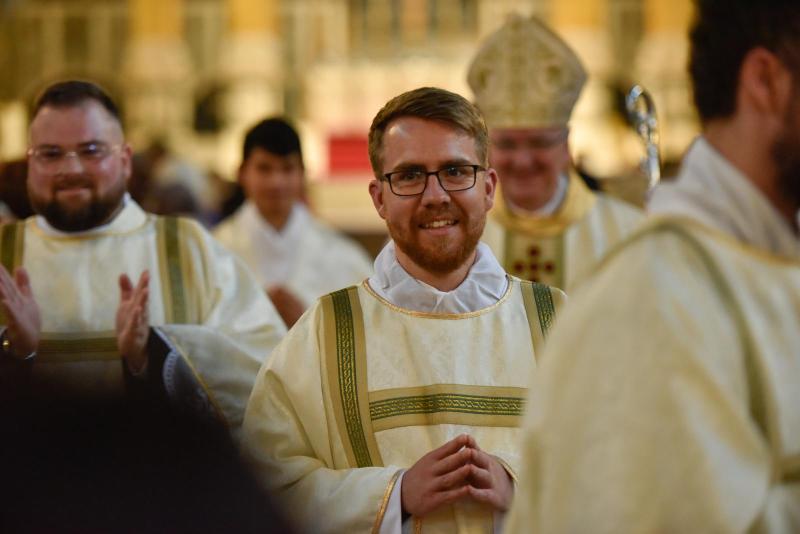My name is Chinedu Udo and I am currently in my fourth year of seminary formation for the priesthood here in Westminster diocese. Originally I am from Nigeria as anyone can tell from my typical African accent! I want to share with you something of my story and I would like to begin by asking you to imagine that you are in the sacristy of your parish church, where the priest’s vestments are carefully laid out in preparation for Mass – his amice, alb, cincture, stole and chasuble. Each of these items offers a clue and sign of how God has spoken and continues to speak to me in my life.
The first thing I want to show you is the amice. It is from the Latin word, “amicere” which means “to cover”.
Think of the image of a criminal who has been captured and is being transferred to prison, and how his face, his head are covered as a sign of his humiliation. Jesus was treated as a prisoner and was assaulted and humiliated during his Passion. In the same way the priest is called to share and unite his humiliations, struggles and weaknesses with Christ himself. So this simple piece of cloth is to remind the priest that he is not only conforming himself to the humiliation of Christ, but also that he needs Christ and the helmet of salvation against the wiles of the enemy. The priest prays while putting on the amice, “Place upon me, O Lord, the helmet of salvation, that I may overcome the assaults of the devil.”
The second item is the alb, which is from the Latin word “alba” meaning white. This signifies purity – once again as a sign that the priest is called to live a life of purity in heart, mind and body in imitation of Christ.
Next is the cincture – which signifies the vow of celibacy which the priest made at his ordination. The priest is called to live a life of chastity and continence in a joyful and life-giving way.
Fourthly, we have the stole, which is a symbol of the immortality of Christ, as well as of the office and authority of Christ the High Priest. This is why whenever a priest is hearing confessions he has to put it on, whenever he celebrates Mass, baptises – at all his priestly functions he puts this on.
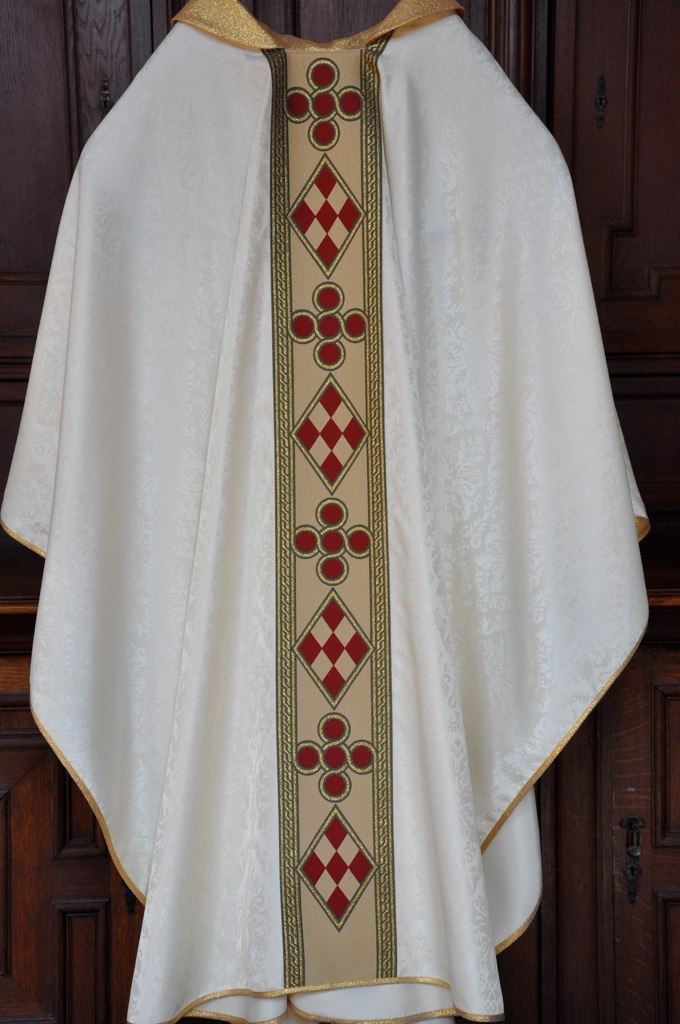 Finally, the chasuble signifies the yoke of unselfish service and charity of Christ. Why would the priest put something on top of his authority [stole]? Why does he wear the stole under the chasuble? It is because the hallmark of the priesthood is pastoral charity. As Blessed John Paul II wrote: “The office of pastoral charity is what is at the heart of the priesthood”. This means the ability of the priest to love as Christ did, and serve God, the Church and Christ’s faithful as Christ himself served. It is the selfless love and the charity of Christ himself and should remain the essential heartbeat of the priesthood. That is why the chasuble (yoke and charity) must be [worn] above or on top of all other vestments.
Finally, the chasuble signifies the yoke of unselfish service and charity of Christ. Why would the priest put something on top of his authority [stole]? Why does he wear the stole under the chasuble? It is because the hallmark of the priesthood is pastoral charity. As Blessed John Paul II wrote: “The office of pastoral charity is what is at the heart of the priesthood”. This means the ability of the priest to love as Christ did, and serve God, the Church and Christ’s faithful as Christ himself served. It is the selfless love and the charity of Christ himself and should remain the essential heartbeat of the priesthood. That is why the chasuble (yoke and charity) must be [worn] above or on top of all other vestments.
So when you see a priest wearing these vestments, they are not just some fancy things that he puts on – they all have their deep significance. They symbolise the true meaning of the priesthood which the priest has been called to live out in his daily life and ministry.
What do these things have to do with my vocation?
I was brought up in Nigeria and when I was 7 years old, after I had made my First Holy Communion, I was invited to become one of the altar servers in my parish. I was told to come for a training session to learn how to set up the priest’s vestments. But the question for me in my mind was “In which order does the priest put on all these things?” I remember going for a servers’ training session on a Saturday morning so that the priest and the MC could show me how to prepare the vestments. It goes: amice, alb, cincture, stole and chasuble. I remember coming out of the church and going back home singing to myself all the way, “Amice, alb, cincture, stole and chasuble. Amice, alb, cincture...” My mother saw me coming down the road singing to myself and doing a little dance as I walked. She said to me “What is the matter with you?” I replied “I am going to set up the vestments tomorrow.”
At the Sunday morning Mass I did very well and remembered everything. After a few months, I came home to my Mum and said “I want to become a priest.” She said, “O my boy! You mean, you would like to become a priest when you get older.” I said, “No, I want to become a priest NOW.” She explained to me that I would need to finish secondary school first, that the priest doesn’t get married, that he has to cook for himself, that he has to get up very early in the morning to celebrate Mass and then by the time he gets home from other out-stationed parishes in the evening it is already dark. My brothers and sisters thought, perhaps this is a mere wishful thinking from a child who knows nothing. They did their best to make me change my mind!
Later in my teenage years, I asked if I could live with and learn from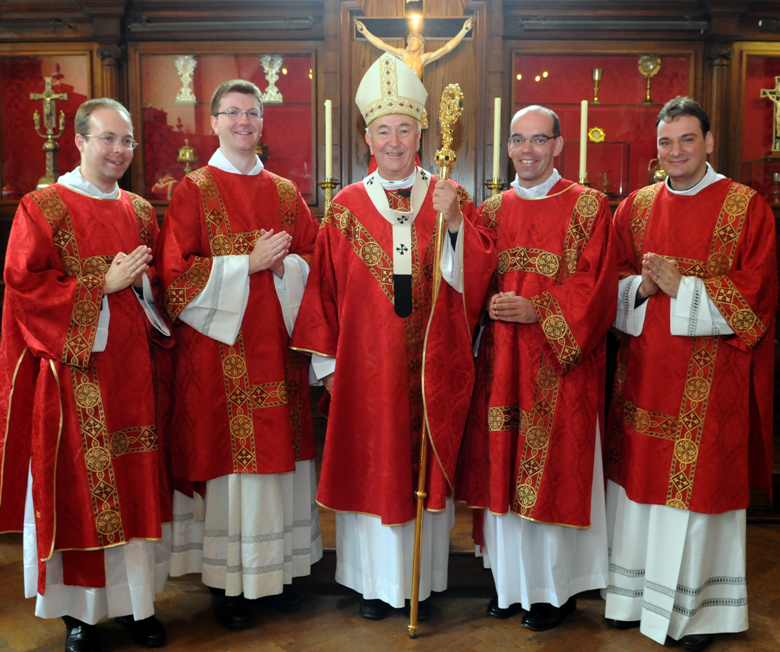 a very holy and prayerful priest of our region. This was a great eye-opener for me as I began to learn from him what the life of the priest was really about. But then my family decided to send me to the United Kingdom to study. I think that behind this was the idea that I would forget all about becoming a priest. But then when I came to the United Kingdom, what did I see? Very nice churches! With beautiful pipe organs!
a very holy and prayerful priest of our region. This was a great eye-opener for me as I began to learn from him what the life of the priest was really about. But then my family decided to send me to the United Kingdom to study. I think that behind this was the idea that I would forget all about becoming a priest. But then when I came to the United Kingdom, what did I see? Very nice churches! With beautiful pipe organs!
When I came to England in my early 20’s to further my academic pursuit in Information System and Technology I was still thinking about priesthood. While studying in College I was also in a pre-discernment programme to deepen my faith and possibly to apply to the seminary for the Archdiocese of Westminster. I graduated from college in 2008 and was accepted to the seminary in 2009 by the then Archbishop of Westminster Diocese, Cardinal Cormac Murphy O’Connor.
Since 2009 I have been at Allen Hall seminary, which has been a wonderful time for me. I have just started my fourth year of formation, which is my pastoral year. This means I am spending the whole year in the parish of St Agnes’ in Cricklewood. During all this time I have come to the understanding more and more that being a priest is not about wearing beautiful vestments, but it is about living the life which embodies the meaning of these vestments. Remember that these vestments point to the office of charity, which is the office of love, the love of God, the love of the Church and the love of the people God has called you to serve.
Life in Seminary
What do we do in the seminary? We build our lives on the four pillars of formation: the academic, the pastoral, the human and the spiritual formation. Academic formation means that we study philosophy and theology – not as a means to get diplomas and certificates but as a way of disciplining our mind in order to truly serve the people of God. Very few people are going to ask you about St Thomas Aquinas in the future as a parish priest, but the studies help to transform your heart and mind into the heart and mind of Christ himself. This is the deepest identity of the priest - to be “another Christ” (alter Christus), because he is configured “in persona Christi capitis”.
Then pastoral formation of course, we [as seminarians] are not yet able to celebrate the sacraments but at the same time we need to be already exercising the office of love in the parish to the people we meet there. We are called to love, to serve and cherish them: “I have come not to be served but to serve” as Christ himself said. Pastoral formation entails taking on Christ’s own pastoral heart so as to be a true Shepherd of souls.
Then spiritual formation – reading about Cardinal Hume’s life reminds me that a man of God is a man of prayer. He was such a prayerful priest and in his own words he succinctly puts it: “make space every day for a quarter to a half hour of prayer.” Just as you can’t run your car without fuel and engine oil so you can’t live your life of faith as a priest without prayer and “Spiritual Directions”. God has to be the centre of your life so that he can truly work through you. Priesthood is not about me, it is all about God and His call to Holiness. The priest is the microphone God uses to speak and the ‘current’ needs to be kept alive through prayer. The priest is called to unite himself with Christ and be in communion with God.
Finally what is human formation in the seminary? Yes, we are preparing to become priests, but we are still human beings! We are not angels dropped down from heaven. We need to realise our weaknesses and our strengths and to find a healthy balance in our lives. There is a word “congruity” which means that the inner self and the outer self merge together, they are consistent. So the priest in the presbytery and the pub, in the church and on the tube should be the same person, not different personas for different situations. We need to understand who we are and how/where we need to grow to become more like Christ. The priest, in a particular way, is called to show the face of Christ to the world, wherever he may find himself, he is called to radiate the love of Jesus. Thomas Merton reminds us “Love is the revelation of our deepest person potential and meaning and value and identity.” And of course Blessed John Paul II reminds us seminarians that “We are speaking of a love that involves the entire person, in all his or her aspects - physical, psychic and spiritual…” (Pastores Dabo Vobis 44). We need to be fully matured, well integrated and have a good sense of freedom and inner peace.
So the seminary is helping me to discover, in all these different areas, that pastoral charity and the love of Christ need to be at the heart of all that I do and all that I am. Now, when I am in the sacristy before Mass preparing the vestments for Fr Paul, my parish priest here in Cricklewood, I say with great humility, “Please God, I hope that one day I may be worthy to put on these vestments”. And the most important thing is that my life should be able to mirror exactly what these vestments symbolize: the total and unconditional love and charity of Jesus Christ.

